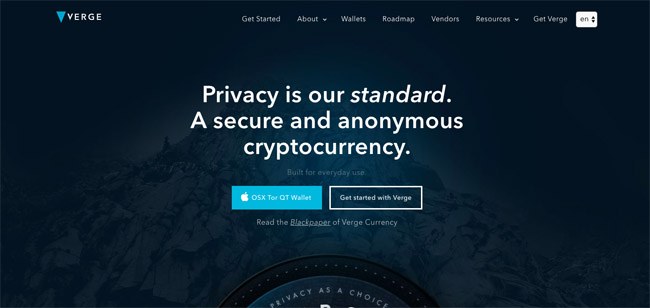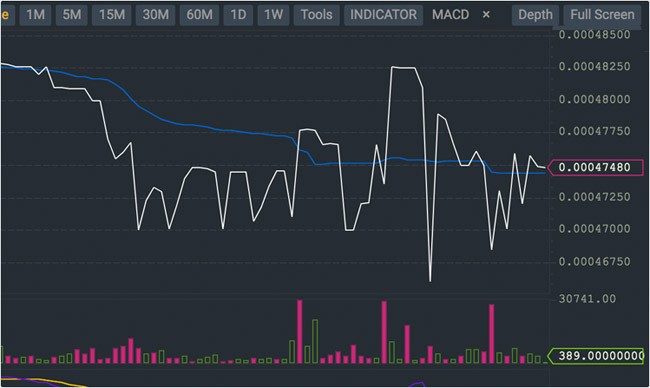Verge became one of the most talked about cryptocurrencies in early 2018 as it climbed higher during the first quarter of the year while the broader markets were falling sharply. In fact, Verge (XVG) was one of only two cryptocurrencies to put in a positive performance in the first quarter of 2018.
One of the reasons for the rising coin price is the active global developer pool and equally active user community. With use cases for the blockchain and coin growing there’s a very good chance that Verge will become one of the long-term projects that remains viable into the future.
Verge has even been able to bounce back from repeated 51% attacks, with the developers enacting an emergency hard fork and software updates. Since May the coin and network have been secure, and the future once again is looking bright for Verge and Verge holders.
The rest of this guide will cover everything you need to know about Verge, including history, coin price action, and future expectations.
Verge Review: What is Verge (XVG)
Verge has a pretty long history among cryptocurrencies, having first been released in 2014 as DogeCoinDark. Verge was not a fork of Dogecoin, it uses its own custom code, but it used the name of the famous meme coin to help gain early traction.
The coin was rebranded as Verge in 2016, and has seen increasing adoption and traction since.
When it was created Verge was meant to improve upon the ideas embodied in the Bitcoin blockchain. One of these includes mining, and while Verge is minable like Bitcoin, it also allows for the use of five different algorithms in mining; Scrypt, X17, Lyra2rev2, myr-groestl and blake2s. This gives miners far more flexibility when mining.
In addition, Verge has greatly improved on privacy and anonymity when compared with Bitcoin. In fact, Bitcoin is not anonymous at all, but Verge masks its transactions with both TOR and i2P to provide users a completely anonymous experience.
The Verge development team has also recognized the utility of smart contracts on blockchains. With that in mind, they partnered with Rootstock (RSK) in June 2018 with plans to integrate the RSK Smart Contracts directly into Verge.
These are just a few of the improvements being made to set Verge apart from other blockchain projects such as Bitcoin, Litecoin, Monero and Dash. Verge has set itself apart by looking for new ways to meet the needs of a diverse user group.
As an increasing number of merchants opt to accept Verge the user community will continue to grow, and that growth will pick up in pace as users come to see that the secure, fast, private and inexpensive transactions offered by Verge are exactly what the world needs in a transactional payment cryptocurrency.
Verge Review: How is Verge Unique
Verge was intentionally created with a large maximum supply of 16.5 billion XVG, with the cap to be reached through mining within 8 years. This is different from other transactional cryptocurrencies such as Bitcoin, where the total number of coins, or maximum supply, have been kept intentionally low to encourage higher prices.
In the case of Bitcoin the maximum supply is just 21 million coins. This keeps the value of a single Bitcoin high, but it also means that users have to deal with large fractional Bitcoin amounts, such as 0.00036 BTC, to make simple payments.
Because Verge has a large supply the price remains low, and users can make payments in more sensible amounts such as 1,000 XVG.
How did Verge Emerge as a Cryptocurrency
Starting with Bitcoin the early cryptocurrencies were all minable and their users let powerful computers go to work solving complex cryptographic problems to get rewarded with the cryptocurrencies they favored. This was a slow and steady introduction of coins into the ecosystem.
The advent of the Initial Coin Offering (ICO) meant projects could release all the coins at once, selling them and allocating them to various groups, but most importantly netting the project, and its founders, huge profits all at once.
This ICO model has given some great projects the means to grow and improve much faster, but the instant gratification aspect of the ICO also gave rise to many scammy projects and was likely the reason we see so many shitcoins in the market these days.
Verge was built along the same lines as older coins and it is fully mineable. Even the Verge developers have to mine for their coins or buy them in the open marketplace.
Verge mining remains profitable because it can be done by any one of five different algorithms, several of which are ASIC resistant. This means Verge miners can choose an option that supports the network, without supporting the ASIC mining rig companies and cartels.
Verge Review: Verge (XVG) Price History
Verge was launched back in 2014 when very few people had even heard of cryptocurrencies, let alone owned or mined for them. In those days 1 XVG was literally worth just millionths of a dollar. And it stayed at those levels until 2017, when cryptocurrencies gained massive publicity thanks to the huge spike at the price of Bitcoin, followed by the rise of nearly every other cryptocurrency.
That spike saw Verge hit an all-time high of $0.2272 by December 23, 2017. After that, the price declined along with the rest of the market, although as of October 2018 the price has been recovering from its lows of $0.010608 hit in August 2018. Currently (October 9, 2018) the price of 1 XVG is $0.015935.
Some claim that the April/May controversy over Verge (more on this later) had some impact in pushing prices lower, it’s hard to say if this is true since the entire cryptocurrency market was falling during that period. Honestly, the drop was steady so it doesn’t look as if any panic selling was occurring.
Verge Review: The Team
One common factor in all the coins that have been released with a premise or an ICO is that they are all controlled by some company or centralized organization. Verge is not controlled by any centralized entity. All the developers that work on Verge are volunteers. Some are successfully early adopters of Verge, while others are supported by XVG donations from the Verge community.
Verge is known as a privacy coin, and that extends to the major developers of the coin as well. Many of the best and most active, while having gained solid reputations, remain anonymous and hidden behind some pseudonym. Some of the best known include:
Sunerok: This is the developer who founded Verge back in 2014 (as DogeCoinDark), and he has continued as the lead developer of the project and top Verge evangelist. He has over 20 years experience in the realm of digital security and more than 7 years in blockchain development.
CryptoRekt: As the Verge team grew it required some management, and CryptoRekt is the person who stepped up and created the Verge Core Management Team. This helps manage the huge group of volunteer Verge developers who reside all across the globe, spanning 15 different time zones and multiple languages. CryptoRekt has been in blockchain development since the early days and has roughly 10 years of cryptocurrency experience.
Other influential developers: There are many other developers, and some of the best known include Sashi, SpookyKid and Kieran Daniels. They have all gained a close association with Verge, and like many other developers, some of them remain a mystery to the broader community. They all have one thing in common though, and that’s a demonstration of their commitment to the Verge project and the skill with blockchain development.
The Verge 51% Attacks
Verge was the victim of a 51% attack that took over the network and stole 250,000 XVG in April 2018. That was a fairly small hack and the developers quickly forked Verge to roll back before the attack.
For those who don’t know, a 51% attack occurs when a single mining interest takes control of more than 51% of the world’s mining power for a single cryptocurrency. This majority status enables this entity to make any changes they like to the network – almost always with the intent of performing fraudulent actions which will net them enormous profits very quickly.
The project was then attacked several weeks later when hackers added a second algorithm to exploit the same vulnerability previously used by the attackers. At the peak of this second attack, the hackers were mining (and stealing) 25 blocks per minute, or roughly 8250 XVG or $950 a minute. Overall 20 million XVG worth roughly $1.1 million was stolen.
The Verge team forked the blockchain again and made software code changes in the coming days, yet it didn’t stop another 51% attack from occurring in May 2018. This time the attackers were able to collect roughly 35 million XVG worth $1.75 million. The blockchain was forked once again and has been secure since.
Investor confidence seemed shaken at the time of the hacks, but the coin price didn’t plummet as might have occurred. The good news is that the Verge team has learned a lot about securing their blockchain from future attacks.
Verge Review: Conclusion
Verge is somewhat amazing because it existed in relative obscurity for roughly three years before skyrocketing, both in price and in prominence over a fairly short 12 month period. From its early and humble beginnings, it has risen to one of the top 40 cryptocurrencies in the world by market cap.
While many just focus on the privacy aspects of Verge, the project is still attempting to secure the top spot for a transactional payment coin that offers complete privacy and anonymity.
There are several very good privacy coins like Monero and Zcash, and there are good payment coins as well, but there isn’t yet a coin that combines the two features to offer convenience, ease of use and privacy.
Like all cryptocurrencies, we’ll have to wait and see if Verge can realize its dreams of success in becoming the top payment cryptocurrency. They’ve set a good foundation over the past five years, and it remains very early in the cryptocurrency game. Verge has seen success in the past, and could easily see its fortunes recover and turn higher once more.

